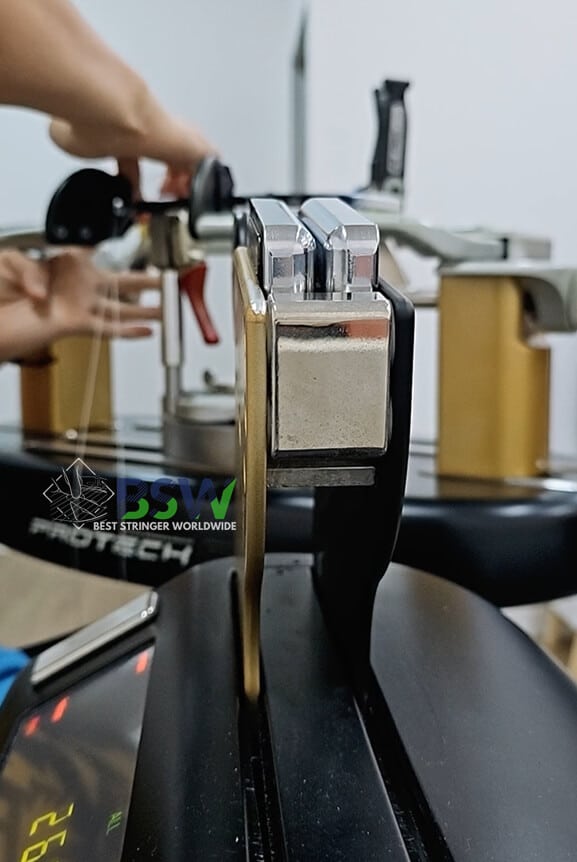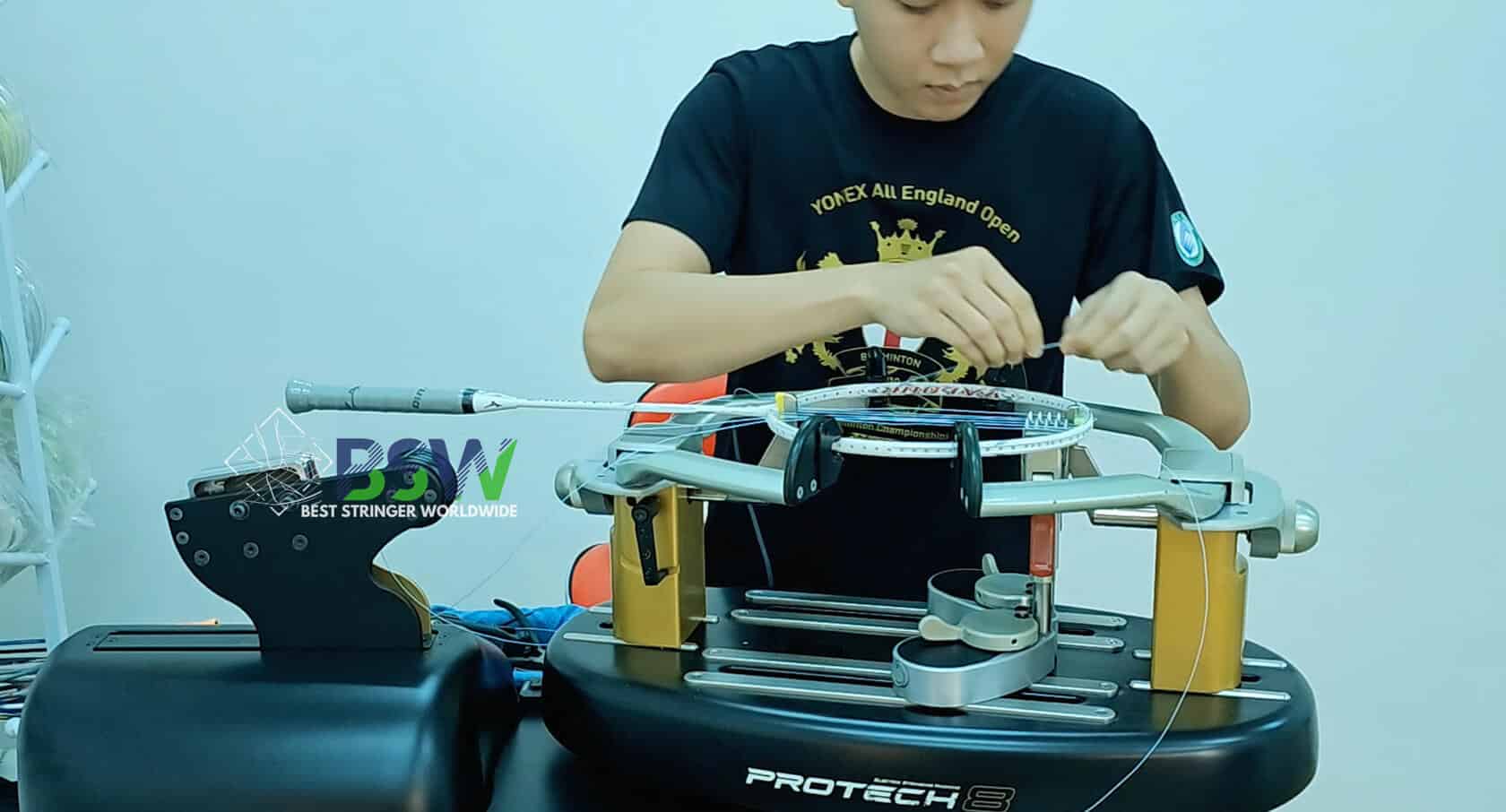At Best Stringer Worldwide (BSW), we’re committed to helping stringers and players improve their craft. Whether you’re pursuing racquet stringing certification or looking to enhance your skills as a professional stringer, understanding the essential measurement equipment for racquet stringing is crucial. This comprehensive guide will explore various measurement tools, their importance, and how they contribute to achieving precise and consistent results in racquet stringing.
The Importance of Accurate Measurements in Racquet Stringing
Accurate measurements are the foundation of professional racquet stringing. They ensure consistency, optimize performance, and contribute to player satisfaction. As you work towards your stringing certificate or refine your skills as a professional stringer, mastering the use of various measurement tools will set you apart in the industry.
Types of Measurement Equipment
Measurement equipment for racquet stringing ranges from simple, single-purpose tools to sophisticated multi-functional devices. Prices can vary from a few dollars to several thousand dollars. Let’s explore the essential measurement tools every professional stringer should be familiar with:
1. Balance Board
A balance board is a crucial tool for measuring the balance point of racquets of different lengths. Key points about balance boards include:
- Many brands offer professional-grade balance boards
- Some models, like those from Alphe (Viper), use fiberglass scales and metal rollers for ease of use
- Specialized balance boards are available for specific sports, such as Forten’s badminton-specific balance board
Understanding and adjusting racquet balance is a key skill for those pursuing racquet stringing certification, as it directly impacts a racquet’s performance characteristics.
2. Electronic Scale
An electronic scale is a versatile tool used to measure the weight of various components, including:
- Racquets
- Strings
- Lead tape and other weight adjustment materials
Electronic scales are widely available and are an essential part of a professional stringer’s toolkit. Accurate weight measurements are crucial for maintaining consistency across multiple racquets and for precise customization.

3. Stringbed Stiffness Tester
A stringbed stiffness tester, such as the popular ERT300, is used to measure the hardness of the stringbed. This tool is invaluable for several reasons:
- It allows stringers to ensure consistent tension across multiple racquets
- Many professional players carry their own tester to verify stringbed stiffness
- It’s a standard tool for tournament stringers to avoid disputes about string tension
The ERT300 uses electronic micro-vibrations to simulate ball impact, providing accurate measurements for any strung racquet, regardless of the sport. Key points about stringbed stiffness testing include:
- Measurements are given in “DT value” (Dynamic Tension)
- The international standard unit is KP/cm or N/mm
- Higher DT values indicate better control (stiffer stringbed)
- Lower DT values suggest more power (greater energy return from the stringbed)
For professional stringers, understanding and utilizing stringbed stiffness measurements is crucial for providing consistent, high-quality service.
DT Value Simulator
Adjust the sliders to see how different factors affect the DT value:
Estimated DT Value: 50 KP/cm
4. Tension Calibrator
A tension calibrator is used to verify the accuracy of a stringing machine’s pulling force. There are two main types:
- Spring-based calibrators
- Electronic calibrators
Using a tension calibrator is essential for maintaining the accuracy of your stringing machine. Best practices for using a tension calibrator include:
- Calibrate your machine after stringing every 25 racquets
- Check calibration when switching between significantly different tensions (e.g., from tennis to badminton)
- Always calibrate after moving or transporting your stringing machine
- Start adjustments from a lower tension and gradually increase
Regular calibration is a hallmark of professional stringers and is often covered in racquet stringing certification programs.
5. Swingweight Meter
A swingweight meter is crucial for racquet customization. It measures the racquet’s resistance to rotation, which affects its maneuverability and power potential. Key points about swingweight meters include:
- They can detect differences in swingweight even when racquets have identical static weight and balance
- Essential for fine-tuning racquet performance
- Helps in matching racquets for players who use multiple frames
Understanding and adjusting swingweight is an advanced skill that sets apart expert stringers in the industry.
6. Comprehensive Testing Devices
Comprehensive testing devices, such as the Babolat RDC (Racquet Diagnostic Center), offer a complete suite of measurement capabilities in one unit. These devices can measure:
- Racquet frame stiffness
- Stringbed stiffness
- Balance point
- Weight
- Swingweight
While expensive, these comprehensive devices are invaluable for professional stringers and are often used in high-level tennis organizations and research institutions.
The Role of Measurement in Professional Stringing
Measurement Equipment Comparison
| Equipment | Function | Price Range | Importance |
|---|---|---|---|
| Balance Board | Measures racquet balance point | $50 – $200 | |
| Electronic Scale | Measures weight of racquets and components | $20 – $100 | |
| Stringbed Stiffness Tester | Measures stringbed stiffness | $300 – $1000 | |
| Tension Calibrator | Verifies stringing machine accuracy | $100 – $800 | |
| Swingweight Meter | Measures racquet swingweight | $500 – $2000 |
For those pursuing a racquet stringing certification or working as professional stringers, mastering the use of measurement equipment is crucial. Here’s why:
- Consistency: Accurate measurements ensure consistent results across multiple racquets.
- Customization: Precise measurements allow for detailed customization to meet player preferences.
- Quality Control: Regular measurements help maintain the quality of your stringing service.
- Problem Solving: Measurement tools can help diagnose issues with racquets or strings.
- Professional Credibility: The ability to provide and interpret accurate measurements enhances your reputation as a stringer.
Best Practices for Using Measurement Equipment
To get the most out of your measurement equipment and provide the best service to your clients, follow these best practices:
- Calibrate your equipment regularly
- Keep detailed records of measurements for each client’s racquets
- Use measurements to educate clients about their equipment
- Stay updated on new measurement technologies and techniques
- Practice interpreting measurement data to improve your stringing and customization skills
Investing in Measurement Equipment
While quality measurement equipment can be a significant investment, it’s essential for providing professional-level service. Consider the following when building your measurement toolkit:
- Start with essential tools like a balance board, electronic scale, and tension calibrator
- Gradually add more specialized equipment as your business grows
- Look for multi-functional devices to maximize value
- Consider the types of racquets and clients you typically work with when choosing equipment
- Factor in the cost of regular calibration and maintenance
The Future of Racquet Measurement Technology
As technology advances, we can expect to see new innovations in racquet measurement equipment. Some potential developments include:
- Integration of AI and machine learning for more precise measurements and predictions
- Wireless and app-connected measurement devices for easier data tracking and sharing
- More affordable versions of comprehensive testing devices
- Advanced sensors for real-time measurement during play
Staying informed about these developments will be crucial for professional stringers looking to maintain a competitive edge in the industry.
Test Your Racquet Balance Knowledge
BSW Certification Tester Final Advice
Mastering the use of measurement equipment is a crucial step in becoming a professional stringer or advancing your career in racquet stringing. These tools not only ensure the quality and consistency of your work but also allow you to provide valuable insights and customization options to your clients.
At Best Stringer Worldwide (BSW), we're committed to providing educational resources to help stringers and players improve their skills. By understanding the importance of accurate measurements and staying updated on the latest measurement technologies, you'll be well-equipped to provide top-notch stringing services and advance in your professional stringing career.

About Best Stringer Worldwide
Best Stringer Worldwide is a comprehensive badminton and tennis stringing education program. We provide in-depth training on stringing techniques, racquet technology, and player-specific customization. Our curriculum is designed to help stringers understand and meet the needs of all badminton players, from casual enthusiasts to competitive athletes.
Read More